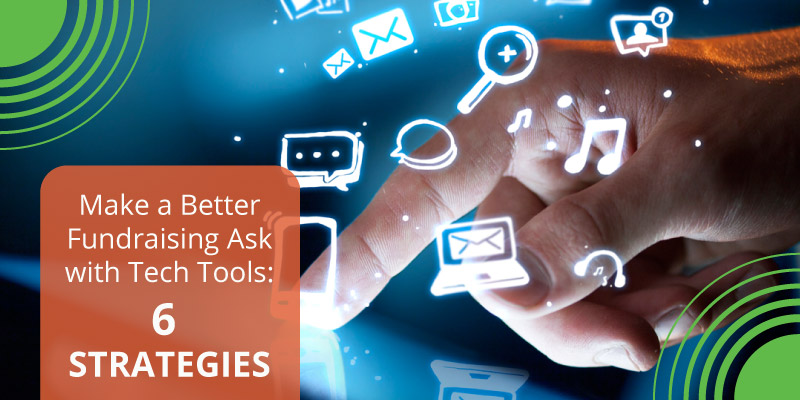This post was contributed by Abby Jarvis at Qgiv.
Your nonprofit already has a few time-tested fundraising techniques up its sleeve. The institutional knowledge that grows at experienced nonprofits can be astounding, leading to incredibly successful campaigns year after year.
Your organization probably also recognizes the importance of building a great website and using nonprofit-centric web design tools. You work hard to ensure that your site perfectly explains your mission and keeps your supporters updated on all your activities.
Fully uniting these two areas, however, can be a major challenge for some nonprofits.
Your fundraising and technological know-how should fully complement and support one another. Incorporating even a few smart tech tools into your fundraising and solicitation strategies can provide a considerable boost and set new standards for your campaigns.
We’ve compiled a selection of effective and simple ways to make a better fundraising ask using new tech tools and strategies:
- Gamify your online fundraising campaigns.
- Promote matching gifts whenever possible.
- Use a fully customized donation page.
- Offer incentives that boost campaign engagement.
- Take advantage of social media fundraising tools.
- Study up on fundraising and donor analytics.
If you’re not using smart fundraising strategies and tools designed specifically for nonprofit organizations, you’re missing out. There are plenty of nonprofit-centric alternatives to the dominant PayPal style platforms out there.
Always look for the right tools and creative strategies for the best fundraising results. Use these tips as a launchpad for your nonprofit to take its digital efforts to the next level.
1. Gamify your online fundraising campaigns.
Gamification tools, or digital tools that amp up good-natured competition among your dedicated supporters, are an extremely effective way to boost engagement and solicit donations.
Best of all, they’re easy to incorporate into all kinds of fundraising projects.
Most often used in peer-to-peer fundraising platforms, gamification tools are perfect for a variety of contexts. By visually representing the progress of your campaign, the time remaining before your deadline, or rankings of your top donors and fundraisers, these tools will motivate your base by creating a sense of competition and urgency.
Here are three of the most common and useful gamification features used by nonprofits:
- Donor and fundraiser badges. Perfect for peer-to-peer fundraising campaigns, these digital badges are used to signify your top volunteer fundraisers. The sense of accomplishment this gives your volunteers is a strong motivator to raise more.
- Fundraising thermometers. A classic fundraising motif, digital fundraising thermometers are a great tool for motivating donors in any campaign. Set a goal and a timeline, then let your donors check on the progress of your campaign. Check out Qgiv’s guide for more on how to use fundraising thermometers and why they’re so effective.
- Leaderboards. Ideal for peer-to-peer fundraising campaigns, digital leaderboards will list your top volunteers and donors. This can be an excellent motivator, especially if you offer a range of incentives or rewards for volunteers who raise a certain amount of funds.
By simply incorporating some engaging and fun gamification tools into your campaign, it’s much easier to solicit donations from supporters without them even realizing it! They’ll feel motivated to support your cause when they see others getting in on the fun or realize a deadline is approaching.
2. Promote matching gifts whenever possible.
Many nonprofits work hard to solicit corporate sponsorships and special grants, but there’s another aspect of corporate philanthropy that goes seriously underutilized: matching gifts.
Through matching gift programs, companies match donations made by their employees to eligible nonprofits, and some of these programs can be extremely generous!
The easiest way to start benefiting from matching gift funds is to promote them. Many donors are simply unaware that their donations might be eligible for a match! Incorporate matching gifts into your solicitation and marketing strategies whenever possible.
You might include an explanation or matching gift eligibility search tool on:
- Your donation page or donation confirmation page
- A ways to give page that lists donation options
- Newsletters to subscribers and members
- Your email campaigns about upcoming projects and goals
- Social media posts about campaigns or matching gift drives
Learning that their donations can be doubled by their employers is a strong motivator for many donors, particularly your loyal supporters who regularly donate to your cause. Always offer digital tools and program databases to your online donors.
Plus, collecting employment information is a great way to boost the effectiveness of this strategy. Just make sure your team properly organizes, manages, and uses this data to refine the way it targets potential donors.
3. Use a fully customized donation page.
Your nonprofit’s online donation page is among its most important digital assets.
You can develop an effective fundraising and solicitation strategy that attracts new supporters and convinces them to support your work, but if your donation page is poorly designed, all that work might go to waste.
Donor abandonment is a serious issue for nonprofit organizations, and clunky donation pages are often the culprit! As the final step in the online solicitation and donation process, your donation page and form need to be optimized, clearly organized, and easy to use.
There are a number of best practices you can follow to ensure that your donation page doesn’t get in the way of your effective solicitations:
- Eliminate unnecessary or distracting design elements.
- Require donors to complete a minimal number of fields. You can ask for more information after they’ve committed their support.
- Provide a couple of very simple options, like preset donation amounts, recurring gift settings, and matching gift search tools.
- Clearly brand the donation page to your organization with your logo.
- Make sure your donation page is internally hosted or embedded on your site. Directing donors off your domain might raise red flags for some.
Digitally optimizing every element of your donation page will ensure that this final step is seamless, quick, and requires minimal thought from donors. Reducing the chance that donors will become distracted or frustrated is a perfect way to secure all the hard work you’ve put into your campaigns.
4. Offer incentives that boost campaign engagement.
Offering donors a reward, opportunity, or special thanks in exchange for their support is one of the oldest fundraising tricks in the book. Nonprofits of all sizes today continue to rely heavily on donation incentives because they work.
Incentivizing donations is a foolproof way to boost the effectiveness of your fundraising asks. This isn’t because donors simply want a reward but rather the fact that incentives catch our attention, unlike any other marketing strategy.
Nonprofits very effectively utilize incentives in their live fundraising events, but what about online? How can you incorporate incentive strategies into your digital campaigns?
There are a number of ways you can use incentives to bolster and reinforce all your online campaigns:
- Hold contests and challenges in your peer-to-peer fundraising campaigns and offer rewards for winners.
- Host a t-shirt crowdfunding campaign. Designing the perfect t-shirt is a surefire way to catch donors’ attention and secure their donations.
- Offer invitations to campaign finale events or special auctions to your online donors who give a certain amount or within a certain timeframe.
- Reward online donors with raffle tickets or other free rewards for making donations or sharing your content on social media.
Remember to allow your online donors the option to quickly set up an account or add membership options to their transaction! Registrations and membership programs offer great, extended opportunities for engaging supporters with incentives.
5. Take advantage of social media fundraising tools.
Many nonprofits regard their social media accounts as tools solely for engaging supporters, sharing content and updates.
However, social media can be an extremely effective fundraising tool when used in smart ways that unite your marketing and fundraising strategies!
Take a note from the straightforward and extremely effective social media techniques of animal shelters, for instance. In a time when many businesses struggle to attract audiences on platforms saturated with advertising, nonprofits can thrive by creating organic engagement and directly asking for support.
There are two common ways to increase donations on social media platforms:
- Directly embed a donation form in your Facebook page. Market your campaign, attract new donors, and accept their donations all in one place. Streamlining the entire process provides a boost to user experience and makes it easier for donors to support you.
- Directly link to your donation page. On Facebook, Instagram, and other platforms, always provide a direct link to your donation page. Donors won’t mind opening a new window or tab if your form is completely optimized and works great on mobile devices.
Social media often makes a great platform for fundraising asks and driving donations to completion because it allows a streamlined experience for donors. They already follow your updates and content there, why not let them make a quick donation there, too?
6. Study up on fundraising and donor analytics.
Learning from your campaign and marketing data is the smartest way to continually refine your solicitation strategies!
You likely already use a CRM or other donor database to track and record your important data, but are you making the most of it? For heavy-duty analytics and data management solutions, consider hiring a nonprofit tech consultant to help you identify areas for improvement.
For smaller nonprofits or those looking to experiment with new data strategies, explore some more basic steps you can take.
Start by familiarizing yourself and your team with the basics of donor analytics. Then, identify some metrics that might be useful for refining your fundraising techniques.
For instance, let’s say your nonprofit just conducted a relatively successful email campaign to solicit donations. These are some data points you might study to make your next email blast even more effective:
- The rate of recipients who opened the email.
- The relationship between when it was sent and its open rate.
- Clickthrough rates to your donation form from the opened email.
- The number of completed donations corresponding to the email campaign.
- A breakdown of email recipients between new and existing donors.
Knowing even some of this data can go a long way to boost the effectiveness of your next marketing and fundraising campaigns, particularly if your growing nonprofit has never used data analytics strategies before.
Uniting your nonprofit’s most reliable digital and fundraising techniques is a recipe for success! By adopting a handful of new tech tools and strategies, you can see a major return on your fundraising efforts over the long run.
Leverage these tips to craft a new comprehensive strategy for your nonprofit to make more effective digital solicitations than ever before!
Author Bio
 Abby Jarvis is a blogger, marketer, and communications coordinator for Qgiv, an online fundraising service provider. Qgiv offers industry-leading online giving and peer to peer fundraising tools for nonprofit, faith-based, and political organizations of all sizes. When she’s not working at Qgiv, Abby can usually be found writing for local magazines, catching up on her favorite blogs, or binge-watching sci-fi shows on Netflix.
Abby Jarvis is a blogger, marketer, and communications coordinator for Qgiv, an online fundraising service provider. Qgiv offers industry-leading online giving and peer to peer fundraising tools for nonprofit, faith-based, and political organizations of all sizes. When she’s not working at Qgiv, Abby can usually be found writing for local magazines, catching up on her favorite blogs, or binge-watching sci-fi shows on Netflix.

